|
|

The Cisco 6400 Service Connection Manager (SCM) allows you to make and manage network connections through a set of menu options available by right clicking on an appropriate Cisco 6400 Chassis, NSP, NRP, NLC, or port object in MapViewer window. These menu options allow you to create and configure services and subscribers, and to manage the subsequent connection of the subscribers to the services.
 |
Note See the "Cisco 6400 SCM Services" section for a description of each of the service types offered by the Cisco 6400 SCM application. |
This chapter details the tasks that you need to use during day to day service connection management. Service connection management is the name we use to describe combined service and subscriber provisioning. Figure 9-1 describes the basic workflow for service and subscriber provisioning

 |
Note Each of the windows that appear in this chapter are described in greater detail in "Service/Subscriber Provisioning Windows: Detailed Description". |
See the "SCM Tasks" section for details of the SCM tasks that you can execute and the objects that you select to begin the task.
Table 9-1 This section describes the tasks that you execute from each object type using the Cisco 6400 SCM Manager (c6400Manager) view. For example, you would select a Site, Shelf or Chassis object when you wish to deploy a service instance object or select a Shelf or Chassis object when you wish to deploy a connection template.
| Cisco 6400 Task | Objects (that can be selected) to Open the Window | Menu Options to Select to Open Window | |||||||||
|---|---|---|---|---|---|---|---|---|---|---|---|
| Site | Shelf | Chassis | NSP | NRP | NRP ATM Port | Node Line Card | Node Line Card ATM Port | Service Instance | Subscriber | ||
Create Service Profiles | Yes | Yes | Yes | No | No | No | No | No | Yes | No | Cisco 6400 UAC, Profile, Configure, service type |
Deploy Connection Template | No | Yes | Yes | No | No | No | No | No | No | No | Cisco 6400 UAC, Connection Template, Deploy |
Connection Template Configuration | No | Yes | Yes | No | No | No | No | No | No | No | Cisco 6400 UAC, Connection Template, Configure Connection Template |
Deploy Service Instance | Yes | Yes | Yes | No | No | No | No | No | Yes | No | Cisco 6400 UAC, Service, Deploy, service type |
Configure and Commission a Service Instance | Yes | Yes | Yes | No | No | No | No | No | Yes | No | Cisco 6400 UAC, Service, Configure service type |
Deploy Subscriber | Yes | Yes | Yes | No | No | Yes | No | Yes | No | No | Cisco 6400 UAC, Subscriber, Deploy |
Configure Subscriber | Yes | Yes | Yes | No | No | Yes | No | Yes | No | Yes | Cisco 6400 UAC, Subscriber, Configure |
Connect Subscriber | Yes | Yes | Yes | No | No | Yes | No | Yes | Yes | Yes | Cisco 6400 UAC, Subscriber, Connect |
Disconnect Subscriber | Yes | Yes | Yes | No | No | Yes | No | Yes | Yes | Yes | Cisco 6400 UAC, Subscriber, Disconnect |
Many service providers and telecommunications carriers now offer tiered service levels to their customers or subscribers. These service levels are generally defined by the marketing policy of the carrier or service provider. Configuration of the Cisco 6400 SCM service and subscriber provisioning involves the definition of a large number of parameters that are common across these policies.
The Cisco 6400 SCM uses the concept of a configuration profile to simplify the definition of service parameters.
A configuration profile is a set of configuration parameters (or attributes) that you can set up in advance before the actual configuration operation. These profiles are saved in the Cisco EMF database. The Cisco 6400 SCM profiles speed up both subscriber provisioning and service provisioning.
Without profiles, you would have to enter a repetitive definition of the same (or similar) information for service or subscriber provisioning operations. For example, you may wish to define "bronze" (low data rate, inexpensive), "silver" and "gold" (high data rate, expensive) profiles for subscriber QoS using a connection template. Connection templates therefore provide a simple method of applying information for use during subscriber provisioning and saves retyping all of the QoS parameters individually for each new subscriber. A typical work flow is provided (see Figure 9-2) to help you.

This section describes how to access and configure the Cisco 6400 SCM Service Profile Configuration windows. The values that you select for each service depends on your network topology and market service offerings.
See the "Service/Subscriber Provisioning Windows: Detailed Description" for further information on the meaning of each service topology and service parameter.
Service profiles define configuration parameters for the uplink from the Cisco 6400 UAC to the service provider.
You can set up profiles and apply them or, alternatively, you can set up and apply a profile with some of the parameters set and then configure the remaining parameters manually. The services available on the Cisco 6400 UAC have a number of parameters to configure. It is worth setting up a number of different service profiles with at least some of the values complete (that can be applied later) to save time.
To create a PPPoA-SD service profile, follow these steps:
The PPPoA-SD Service Profile Configuration window appears with the Configuration tab displayed.

Step 2 Select Create Profile.
A Prompt window appears (see Figure 9-4) for you to enter a name for you new profile.

Step 3 Enter a name for the profile in the Enter profile name data entry box. PPPoA-SDSilver was entered in the example shown in Figure 9-4.
 |
Note Each service profile must have a unique name. Do not insert spaces into a service profile name. |
The PPPoA-SD Service Profile Configuration window reappears with the new profile name displayed in the PPPoA-SD Service Profiles list at left side of the window (see Figure 9-5).

 |
Note Select the Copy and Copy Page Configuration options in the Edit menu to cut and paste between different profiles. This is useful when you wish to copy profile information from one to the next. |
Step 4 Configure the parameters in the PPP Session Termination Parameters panel, as required. The PPP Session Termination Parameters describe the PPP characteristics used to terminate the incoming PPP traffic. You should set the parameters appropriate to your network topology and services offered.
 |
Note You can apply an existing profile to a new profile to save time when configuring new profiles. Select the Apply Profile option from the Edit menu and then select the existing profile you wish to apply from the profiles listed. The configuration settings are copied from the existing profile to the new profile. The settings copied appear in blue. |
Step 5 Enter values for the Lower and Higher IP Addresses into the IP Address Pool panel, as required. The IP Address Pool set the range of IP addresses available to a subscriber.
 |
Note If you select to enable the Peer DHCP option, it appears that you are using an external DHCP Server for IP address allocation, and values entered into the IP Address Pool panel are grayed out and ignored. |
Step 6 Select a Subscriber Encapsulation type in the VC Parameters panel. The VC Parameters define the characteristics of the incoming ATM traffic.
Step 7 Select the Service Details tab (see Figure 9-6).
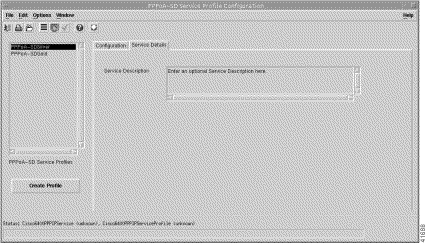
Step 8 Enter a description into the Service Description data entry box in the Service Details panel, if required.
 |
Note Entering a Service Description is optional. |
Step 9 Select Save from the File menu to save the parameters you have selected for your service profile.
Step 10 Select Close from the File menu to close the window.
To edit an existing PPPoA-SD service profile, follow these steps:
The PPPoA-SD Service Profile Configuration window appears with the PPPoA-SD Configuration tab displayed. Existing service profiles are displayed in the PPPoA-SD Service Profiles list at the left side of the window.

Step 2 Select the profile you wish to edit from the list of profiles displayed in the PPPoA-SD Service Profiles list.
Step 3 Edit the parameters displayed in the Configuration and Service Details tabs, as required.
Step 4 Select Save from the File menu to save the changes made to the service profile.
Step 5 Select Close from the File menu to close the window.
To delete an existing PPPoA service profile, follow these steps:
The PPPoA-SD Service Profile Configuration window appears. Existing service profiles are displayed in the PPPoA-SD Service Profiles list on the left side of the window.

Step 2 Select the existing service profile (displayed in the PPPoA-SD Service Profiles list) that you wish to delete.
Step 3 Select the Delete Profile option from the Edit menu. Select the profile you wish to delete from the list displayed.
A Deletion Prompt window appears (see Figure 9-9) for you to confirm that you wish to delete the selected profile.

Step 4 Click Yes to delete the selected profile or click No to close the window without deleting the profile.
When a profile is deleted it disappears from the list of PPPoA Service Profiles in the PPPoA-SD Service Profile Configuration window.
L2TP service profiles define the configuration parameters for the uplink from the Cisco 6400 UAC to the service provider. You can set up profiles and apply them to the relevant NRP or, alternatively, you can set up and apply a profile with some of the parameters set and then configure the remaining parameters manually. The services available on the Cisco 6400 UAC have a number of parameters to configure. It is worth setting up a number of different service profiles with at least some of the values complete (that can be applied later) to save time.
To create an L2TP service profile, follow these steps:
The L2TP Service Profile Configuration window appears with the Configuration tab displayed.

Step 2 Select Create Profile.
A Prompt window appears (see Figure 9-11) for you to enter a name for your new profile.

Step 3 Enter a name for the profile in the Enter profile name data entry box. L2TP Bronze was entered in the example shown in Figure 9-11.
 |
Note Each service profile must have a unique name. Do not insert spaces into a service profile name. |
The L2TP Service Profile Configuration window reappears with the name of the new profile displayed in the L2TP Service Profiles list at left side of the window. See the "L2TP Service Profile Configuration Window" section for details of the parameters displayed.

 |
Note Select the Copy and Copy Page Configuration options in the Edit menu to cut and paste between different profiles. This is useful when you wish to copy profile information from one to the next. |
Step 4 Configure the parameters displayed in the L2TP Configuration tab as required.
 |
Note You can apply an existing profile to a new profile to save time when configuring new profiles. Select the Apply Profile option from the Edit menu and then select the existing profile you wish to apply from the profiles listed. The configuration settings are copied from the existing profile to the new profile. The settings copied appear in blue. |
Step 5 Select the Service Details tab.
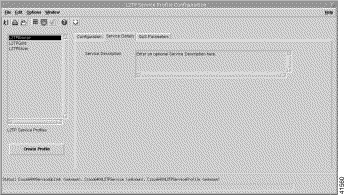
Step 6 Enter a description into the Service Description data entry box in the Service Details panel, when required. Entering a Service Description is optional.
Step 7 Select the QoS Parameters tab.
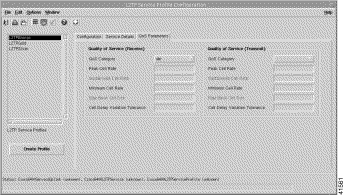
Step 8 Configure the parameters displayed on the QoS Parameters tab, as required.
Step 9 Select Save from the File menu to save the parameters you have selected for your service profile.
Step 10 Select Close from the File menu to close the window.
To edit an existing L2TP service profile, follow these steps:
The L2TP Service Profile Configuration window appears with the L2TP Configuration tab displayed. Existing service profiles are displayed in the L2TP Service Profiles list at the left side of the window.

Step 2 Select the profile you wish to edit from the list of profiles displayed in the PPPoA-SD Service Profiles list.
Step 3 Edit the parameters displayed in the Configuration, Service Details and QoS Parameters tabs as required.
Step 4 Select Save from the File menu to save the changes made to the service profile.
Step 5 Select Close from the File menu to close the window.
To delete an existing L2TP service profile, follow these steps:
The L2TP Service Profile Configuration window appears. Existing service profiles are displayed in the L2TP Service Profiles list on the left side of the window.

Step 2 Select the Delete Profile option from the Edit menu. Select the profile you wish to delete from the list displayed.
A Deletion Prompt window appears (see Figure 9-9) for you to confirm that you wish to delete the selected profile.

Step 3 Click Yes to delete the selected profile or click No to close the window without deleting the profile.
Step 4 When a profile is deleted it disappears from the list of L2TP Service Profiles in the L2TP Service Profile Configuration window.
Service profiles define configuration parameters for the uplink from the Cisco 6400 UAC to the service provider.
You can set up profiles and apply them or, alternatively, you can set up and apply a profile with some of the parameters set and then configure the remaining parameters manually. The services available on the Cisco 6400 UAC have a number of parameters to configure. It is worth setting up a number of different service profiles with at least some of the values complete (that can be applied later) to save time.
To create an RFC1483 Bridging service profile, follow these steps:
The RFC1483 Bridging Service Profile Configuration window appears:
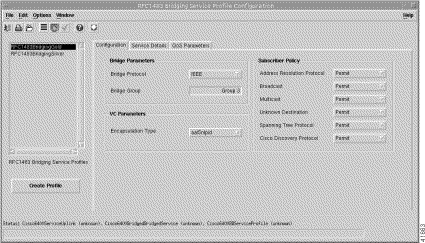
Step 2 Select Create Profile. A Prompt window appears (see Figure 9-19).

Step 3 Enter a name for the profile in the Enter profile name data entry box.
 |
Note Each service profile must have a unique name. Do not insert spaces into a service profile name. |
Step 4 BR1483 Bridging Bronze was entered in the example shown in Figure 9-19. The new profile name appears in the BB Service Profiles list at left side of the window (see Figure 9-20).
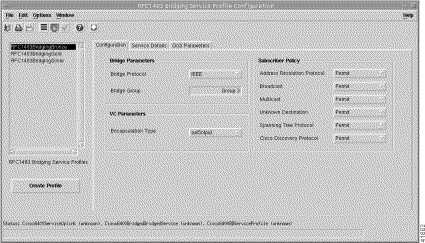
 |
Note Select the Copy and Copy Page Configuration options in the Edit menu to cut and paste between different profiles. This is useful when you wish to copy profile information from one to the next. |
Step 5 Configure the parameters displayed in the Configuration tab, as required. See the "RFC1483 Bridging Service Profile Configuration Window" section for details of the parameters displayed on each of the tabs.
 |
Note You can apply an existing profile to a new profile to save time when configuring new profiles. Select the Apply Profile option from the Edit menu and then select the existing profile you wish to apply from the profiles listed. The configuration settings are copied from the existing profile to the new profile. The settings copied appear in blue. |
Step 6 Select the Service Details tab (see Figure Figure 9-21).
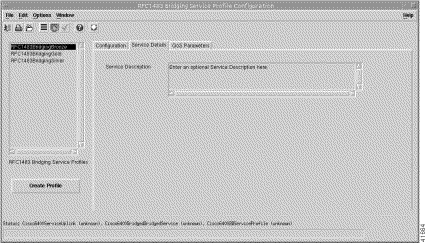
Step 7 Enter a description into the Service Description data entry box in the Service details panel, if required. Entering a Service Description is optional.
Step 8 Select the QoS Parameters tab (see Figure 9-22).
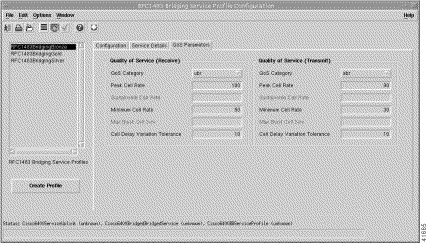
Step 9 Configure the parameters displayed in the QoS Parameters tab, as required.
Step 10 Select Save from the File menu to save the parameters you have selected for your service profile.
Step 11 Select Close from the File menu to close the window.
To edit an existing RFC1483 Bridging service profile, follow these steps:
The RFC1483 Bridging Service Profile Configuration window appears with the Service Details tab displayed. Existing service profiles are displayed in the BB Service Profiles list at the left side of the window.

Step 2 Select the profile you wish to edit from the list of profiles displayed in the RFC1483 Bridging Service Profiles list.
Step 3 Edit the parameters displayed in the Configuration, Service Details, and QoS Parameters tabs, as required.
Step 4 Select Save from the File menu to save the changes made to the service profile.
Step 5 Select Close from the File menu to close the window.
To delete an existing RFC1483 Bridging service profile, follow these steps:
The RFC1483 Bridging Service Profile Configuration window appears. Existing service profiles are displayed in the BB Service Profiles list on the left side of the window.

Step 2 Select the existing service profile (displayed in the RFC1483 Bridging Service Profiles list) that you wish to delete.
Step 3 Select the Delete Profile option from the Edit menu. Select the profile you wish to delete from the list displayed.
A Deletion Prompt window appears (see Figure 9-25) for you to confirm that you wish to delete the selected profile.

Step 4 Click Yes to delete the selected profile or click No to close the window without deleting the profile.
When a profile is deleted it disappears from the list of RFC1483 Bridging Service Profiles in the RFC1483 Bridging Service Profile Configuration window.
Service profiles define configuration parameters for the uplink from the Cisco 6400 UAC to the service provider.
You can set up profiles and apply them or, alternatively, you can set up and apply a profile with some of the parameters set and then configure the remaining parameters manually. The services available on the Cisco 6400 UAC have a number of parameters to configure. It is worth setting up a number of different service profiles with at least some of the values complete (that can be applied later) to save time.
To create an RFC1483 IRB service profile, follow these steps:
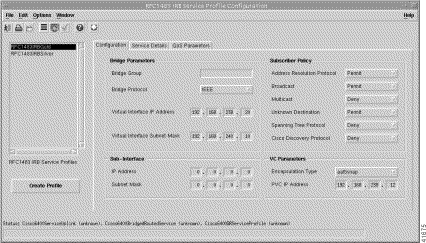
Step 2 Select Create Profile. A Prompt window appears (see Figure 9-27).

Step 3 Enter a name for the profile in the Enter profile name data entry box. Premium Profile was entered in the example shown in Figure 9-27.
 |
Note Each service profile must have a unique name. Do not insert spaces into a service profile name. |
The new profile name displays in the BR Service Profiles list at left side of the window (see Figure 9-28).

 |
Note Select the Copy and Copy Page Configuration options in the Edit menu to cut and paste between different profiles. This is useful when you wish to copy profile information from one to the next. |
Step 4 Configure the parameters displayed in the Configuration tab as required. See the "RFC1483 IRB Service Profile Configuration Window" section for details of the parameters displayed on each of the tabs.
 |
Note You can apply an existing profile to a new profile to save time when configuring new profiles. Select the Apply Profile option from the Edit menu and then select the existing profile you wish to apply from the profiles listed. The configuration settings are copied from the existing profile to the new profile. The settings copied appear in blue. |
Step 5 Select the Service Details tab (see Figure 9-29).
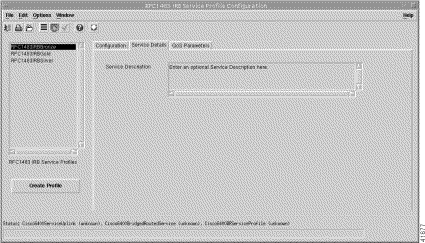
Step 6 Enter a description into the Service Description data entry box in the Service Details panel, as required. Entering a Service description is optional.
Step 7 Select the QoS Parameters tab.
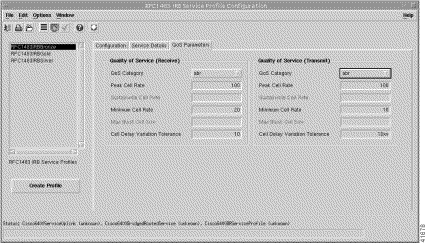
Step 8 Configure the parameters displayed in the QoS Parameters tab as required.
Step 9 Select Save from the File menu to save the parameters you have selected for your service profile.
Step 10 Select Close from the File menu to close the window.
To edit an existing RFC1483 IRB service profile, follow these steps:
The RFC1483 IRB Service Profile Configuration window appears with the BR Configuration tab displayed. Existing service profiles are displayed in the BR Service Profiles list at the left side of the window.

Step 2 Select the profile you wish to edit from the list of profiles displayed in the RFC1483 IRB Service Profiles list.
Step 3 Edit the parameters displayed in the Configuration, Service Details, and QoS Parameters tabs, as required.
Step 4 Select Save from the File menu to save the changes made to the service profile.
Step 5 Select Close from the File menu to close the window.
To delete an existing IRB service profile, follow these steps:
The RFC1483 IRB Service Profile Configuration window appears. Existing service profiles are displayed in the BR Service Profiles list on the left side of the window.

Step 2 Select the existing service profile (displayed in the RFC1483 IRB Service Profiles list) that you wish to delete.
Step 3 Select the Delete Profile option from the Edit menu. Select the profile you wish to delete from the list displayed.
A Deletion Prompt window appears (see Figure 9-33) for you to confirm that you wish to delete the selected profile.

Step 4 Click Yes to delete the selected profile or click No to close the window without deleting the profile.
Step 5 When a profile is deleted it disappears from the list of RFC1483 IRB Profiles in the RFC1483 IRB Service Profile Configuration window.
Service profiles define configuration parameters for the uplink from the Cisco 6400 UAC to the service provider.
You can set up profiles and apply them or, alternatively, you can set up and apply a profile with some of the parameters set and then configure the remaining parameters manually. The services available on the Cisco 6400 UAC have a number of parameters to configure. It is worth setting up a number of different service profiles with at least some of the values complete (that can be applied later) to save time.
To create an IP Uplink service profile, follow these steps:
The IP Uplink Service Profile Configuration window appears (see Figure 9-34) with the Configuration tab displayed.
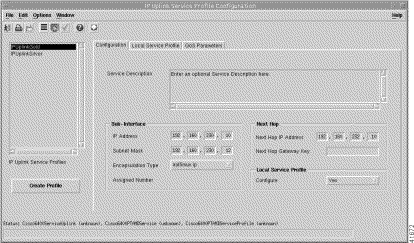
Step 2 Select Create Profile. A Prompt window appears (see Figure 9-35).

Step 3 Enter a name for the profile in the Enter profile name data entry box. IP Uplink Bronze was entered in the example shown in Figure 9-35.
 |
Note Each service profile must have a unique name. Do not insert spaces into a service profile name. |
The new profile name appears in the IP Uplink Service Profiles list on the left side of the window (see Figure 9-36).
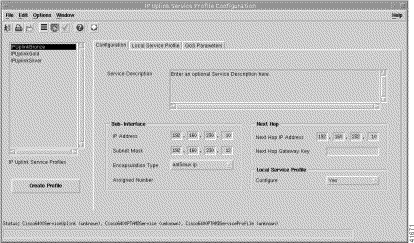
Step 4 Configure the parameters displayed in the Configuration tab (shown in Figure 9-34), as required. The Configure option (in the Local Service Profile panel on the Configuration tab) must be set to Yes to allow you to configure the parameters displayed in the Local Service Profile tab.
 |
Note You can apply an existing profile to a new profile to save time when configuring new profiles. Select the Apply Profile option from the Edit menu and then select the existing profile you wish to apply from the profiles listed. The configuration settings are copied from the existing profile to the new profile. The settings copied appear in blue. |
 |
Note Select the Copy and Copy Page Configuration options in the Edit menu to cut and paste between different profiles. This is useful when you wish to copy profile information from one to the next. |
Step 5 Select the Local Service Profile tab (when applicable).
 |
Note The Configure option (in the Local Service Profile panel on the Configuration tab) must be set to Yes to allow you to configure the parameters displayed in the Local Service Profile tab. |

See the "Local Service Profile Tab" section for details of the parameters displayed.
Step 6 Configure the General, DNS Redirection / Fault Tolerance, and the Remote RADIUS Configuration parameters.
Step 7 Select the QoS Parameters tab.
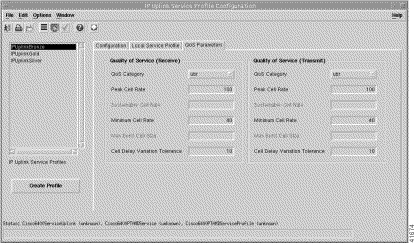
Step 8 Configure the Quality of Service (Receive) and Quality of Service (Transmit) parameters, as required.
Step 9 Select Save from the File menu to save the parameters you have selected for your service profile.
Step 10 Select Close from the File menu to close the window.
To edit an existing IP Uplink service profile, follow these steps:
The IP Uplink Service Profile Configuration window appears with the Configuration tab displayed (see Figure 9-39).

Step 2 Select the profile you wish to edit from the list of profiles displayed in the IP Uplink Service Profiles list on the left side of the window.
Step 3 Configure the parameters displayed in the Configuration, Local Service Profile, and QoS Parameters tabs as required.
Step 4 Select Save from the File menu to save the configuration.
Step 5 Select Close from the File menu to close the window and save the changes made.
To delete an existing IP Uplink service profile, follow these steps:

Step 2 Select the existing service profile (displayed in the IP Uplink Service Profiles list) that you wish to delete.
Step 3 Select the Delete Profile option from the Edit menu. Select the profile you wish to delete from the list displayed.
A Deletion Prompt window appears (see Figure 9-41) for you to confirm that you wish to delete the selected profile.

Step 4 Click Yes to delete the selected profile or click No to close the window without deleting the profile.
Step 5 When a profile is deleted it disappears from the list of IP Uplink Service Profiles in the IP Uplink Service Profiles Configuration window.
Connection Templates are very similar to VC Classes in Cisco IOS. The main difference is that, where a VC class is local to a specific NRP, Connection Templates are available for each Cisco 6400 UAC managed by the Cisco 6400 SCM application. When a parameter in a connection template is altered and applied, this change applies to all connections that use the template. A connection template is basically a "wrapper" that represents several VC classes, one for each NRP.
Connection templates allow you to set the QoS parameters for the connection between the subscriber PVC and the selected NRP. The connection templates are applied later when connecting the subscriber to a service instance. See the "Connecting a Subscriber to a Service Instance" section for further details on connecting subscribers to a service instance.
Figure 9-42 shown an example workflow for creating and configuring connection templates.
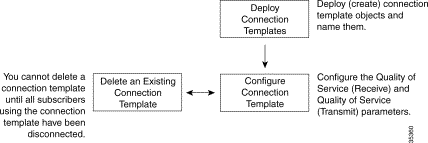
To deploy a Connection Template, follow these steps:
Step 2 Click and hold down the right mouse button.
Step 3 Select the Deployment, Cisco 6400 UAC, Connection Template, Deploy Connection Template option. The Deployment Wizard - Object Parameters window (see Figure 9-43) appears.

Step 4 Enter the Number of Connection Template objects you wish to deploy.
Step 5 Click Forward.
Step 6 Enter a name for the new Connection Template in the Object Parameters panel.
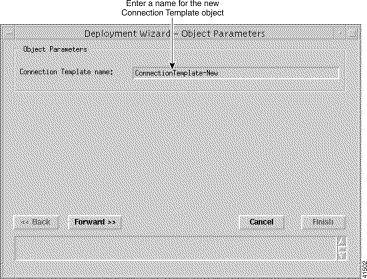
Step 7 Click Forward.
Step 8 Repeat steps 6 and 7 for the Number of Connection Template objects entered in step 4.
Step 9 The Deployment Summary details appear in the Deployment Wizard - Summary window (see Figure 9-45).
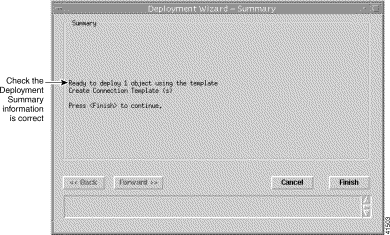
Step 10 Check the summary information displayed is correct.
Step 11 Click Finish (when the Deployment Summary information is correct) to complete the deployment.
After deploying a connection template, you should then configure them. Proceed to the next section "Configuring Connection Templates" for further details.
To configure connection templates, follow these steps:
Step 2 Click and hold down the right mouse button.
Step 3 Select the Cisco 6400 UAC, Connection, Connection Template Configuration option. The Connection Template Configuration window (see Figure 9-46) appears.

Step 4 Select a connection template from the Connection Template list displayed.
Step 5 Configure the Quality of Service (Receive) and Quality of Service (Transmit) parameters, as required. See the"Service/Subscriber Connection Window" section for further details on the parameters displayed.
Step 6 Click Apply to apply the settings to the selected connection template.
 |
Note Connection templates allow you to reconfigure the Quality of Service (Receive) and Quality of Service (Transmit) parameters set for a subscriber without disruption to the service (that is, without having to disconnect a subscriber, change parameters and then reconnect the subscriber). |
Step 7 Select the Close option from the File menu to close the Connection Template Configuration window.
 |
Note Before deleting a connection template you must disconnect any subscribers connected to a service instance using that connection template. |
To delete connection templates, follow these steps:
Step 2 Click and hold down the right mouse button.
Step 3 Select the Cisco 6400 UAC, Connection, Connection Template Configuration option. The Connection Template Configuration window (see Figure 9-46) appears.
Step 4 Select a connection template from the Connection Template list displayed.
Step 5 Click Delete to delete the selected connection template.
Step 6 Select Close from the File menu to close the Connection Template Configuration window.
One of the most important aspect of the Cisco 6400 SCM application is Service Connection Management. The Cisco 6400 UAC contains multiple network elements, an ATM switch, multiple router cards (NRPs), and multiple line cards. Services are deployed across these network elements, a multistage process involving both SNMP and Cisco IOS management commands. The Cisco 6400 SCM application enables point-and-click connection of end subscribers to 6400-based services with all of the underlying Cisco IOS and SNMP operation hidden.
 |
Note See to the "Cisco 6400 SCM Services" section for a description of the service types offered by the Cisco 6400 SCM application. |
The Cisco 6400 SCM software is designed to help simplify Cisco 6400 UAC service configuration. A typical work flow is described in Figure 9-47.
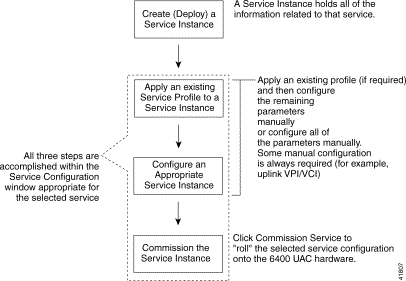
 |
Note The"Configuring and Commissioning a Service Instance" section is the only section that involves direct configuration of the Cisco 6400 UAC hardware. |
A service instance is an object that holds all the information related to that service. A service instance object must be created (deployed) before the service instance can be configured.
This section includes an example that describes how to create a service instance for an ATM Service. The procedure for creating a service instance for any other service types is very similar to that for the ATM Service.
To create a service instance, follow these steps:
 |
Note Where the Appropriate Service is the type of service instance you wish to create (that is, ATM, PPPoA-SD, L2TP, RFC1483 Bridging, RFC1483 IRB, IP Uplink, or RFC1483 Routing). |
The Deployment Wizard Object Parameters (1 of 2) window appears (see Figure 9-48).
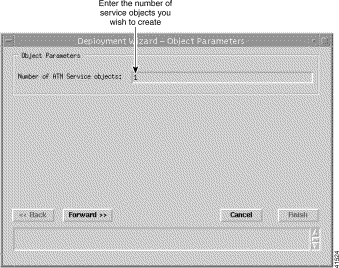
Step 2 Enter the Number of Service objects to create. A single ATM Service object was entered in the example shown in Figure 9-48.
Step 3 Select Forward. The Deployment Wizard Object Parameters (2 of 2) window appears (see Figure 9-49).
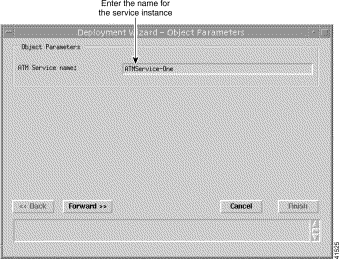
Step 4 Enter a Service Instance Name. ATM Service- One was entered in the example shown in Figure 9-49.
Step 5 Select Forward.
 |
Note Repeat steps 4 and 5 for the Number of Service Instances entered in step 2, when required. |
Step 6 Click Forward. The Deployment Wizard Summary window appears (see Figure 9-50).

Summary information displays in the Summary panel.
Step 7 Check the Summary information is correct.
Step 8 Click Finish (when the Deployment Summary information is correct) to create the new Service Instance objects.
Step 9 Proceed to the "Configuring and Commissioning a Service Instance" section.
The new service instances created now displays in the Cisco 6400 Service View at the left side of the Map Viewer window. You will have to refresh the view. Figure 9-51 shows an example of the ATM Service-ATM Service Instance One service instance created in the previous example.

After you create the service instance object, you should configure and then commission the service instance from the appropriate Service Configuration window. The service instance object can be configured in two ways:
This section describes how launch the appropriate Service Configuration window, apply a service profile (if required), configure the remaining parameters, and then commission the service instance for each of the available Cisco 6400 SCM services. Figure 9-52 displays a typical workflow for configuring and then commissioning a service instance.

To configure and commission a Pure ATM switching service instance, follow these steps:
 |
Note You cannot apply a profile to the pure ATM switching service. |
The ATM Service Configuration window appears (see Figure 9-53). See the "ATM Service Configuration Window" section for further details on the parameters displayed.

Step 2 Select the appropriate Cisco 6400 chassis and ATM Service instance from the lists displayed at the left side of the window.
Only the ATM service instance objects (for the selected chassis) are displayed in the ATM Services list. Service instances for other service types are listed in their appropriate Service Configuration windows. For example, L2TP service instance objects are displayed in the L2TP Configuration window. The ATM Services list is empty when no ATM Service instances have been created. See the "Creating a Service Instance" section for details on how to create a service instance.
Step 3 Enter a Service Description (when required).
Step 4 Select a connection from the ATM Connection list.
Step 5 Enter Subscriber VPI, Subscriber VCI and Subscriber Name in the Subscriber Connections panel, as required.
Step 6 Select the Service Uplink tab.
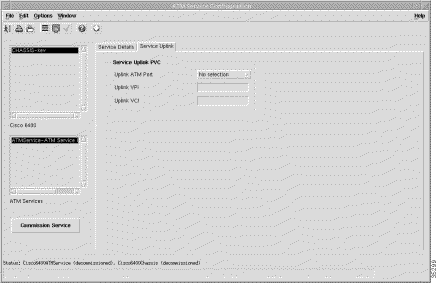
Step 7 Enter details into the parameters displayed in the Service Uplink PVC panel, as required. See the "Service Uplink Tab" section for further details on the parameters displayed.
 |
Note This is the first stage at which you actually "roll" the selected service configuration onto the Cisco 6400 UAC hardware. |
Step 8 Click Commission Service to save the configuration information you have entered and roll the service onto the Cisco 6400 UAC. A pop up window appears for you to confirm that you wish to commission the selected service.

Step 9 Select Yes to commission the service (or No to return to the ATM Service Instance Configuration window without commissioning the ATM service). An Action Report window appears. The Action Report window details the Cisco IOS commands executed when the service is commissioned. Invalid Cisco IOS commands result in a failure to commission the service.
Step 10 Check the details in the Action Report window to ensure that the service was commissioned successfully.
Step 11 Select Save to save the Action Report, if required.
Step 12 Select Close to close the Action Report window and return to the Service Instance Configuration window.
Step 13 Select Close from the File menu to close the Service Instance Configuration window.
To configure and commission a PPPoA-SD service instance, follow these steps:
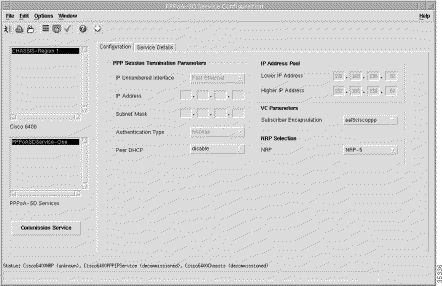
Step 2 Select the appropriate Cisco 6400 and PPPoA-SD Service instance from the lists displayed on the left side of the window.
Only the PPPoA-SD service instance objects (for the selected chassis) are displayed in the PPPoA-SD Services list. Service instances for other service types are listed in their appropriate Service Configuration windows. For example, L2TP service instance objects are displayed in the L2TP Configuration window. The PPPoA-SD Services list is empty when no PPPoA-SD instances have been created. See the "Creating a Service Instance" section for details on how to create a service instance.
 |
Note Proceed to the "Configuring the PPPoA-SD Service Parameters" section if you are not applying a service profile. |
Step 3 Select Apply Profile from the Edit menu.
Step 4 Select the appropriate profile from the list of profiles displayed. The profile parameters are copied to the appropriate service instance parameters in the PPPoA-SD Service Configuration window and appear in blue.
See the "PPPoA-SD Service Profile Configuration Window" section for further details on the parameters displayed.
Step 5 Configure the parameters displayed in the Virtual Template Parameters, IP Address Pool, and VC Parameters panels, as required.
Step 6 Select the Service Details tab.
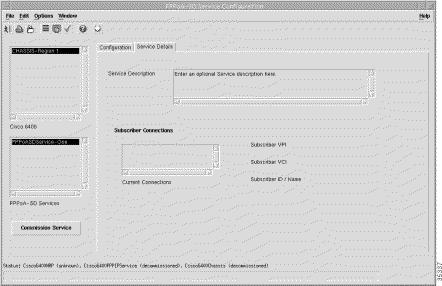
See the "PPPoA-SD Service Configuration Window" section for further details on the parameters displayed.
Step 7 Enter a Service Description, if required.
Step 8 Select a connection from the Current Connection list and configure the values in the Subscriber Connections panel, as required.
Step 9 Click Commission Service to roll the service onto the selected Cisco 6400 UAC. A pop up window appears for you to confirm that you wish to commission the selected service.

Step 10 Select Yes to commission the service (or No to return to the Service Instance Configuration window). The Action Report window appears.
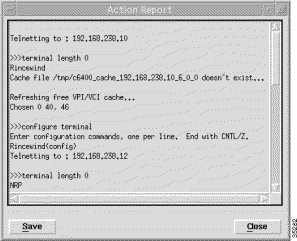
The Action Report window details the Cisco IOS commands executed when the service is commissioned. Invalid Cisco IOS commands result in a failure to commission the service.
Step 11 Check the details in the Action Report window to ensure that the service was commissioned successfully.
 |
Caution The Cisco 6400 SCM will roll-back configuration changes applied if an error is detected in the execution of the Cisco IOS command sequence with your selected parameters. This insures that the Cisco 6400 UAC remains in a consistent state, even when errors are made entering parameters. |
Step 12 Select Save to save the Action Report, if required.
Step 13 Select Close to close the Action Report window and return to the Service Instance Configuration window.
Step 14 Select Save from the File menu to save the parameters configured.
Step 15 Select Close from the File menu to close the PPPoA-SD Service Configuration window.
 |
Note The PPPoA-SD Service requires additional configuration. Proceed to the "Additional IOS Configuration For the PPPoA-SD Service" section for further details. |
For the PPPoA-SD service to pass traffic to a designated trunk port, Cisco IOS must be used (to route traffic via layer 3 to a destination network). One way of doing this is to create a PVC on the NRP to support the routing of traffic to the trunk port and then create the required entries in the IP Routing Table.
To configure and commission an L2TP service instance, follow these steps:
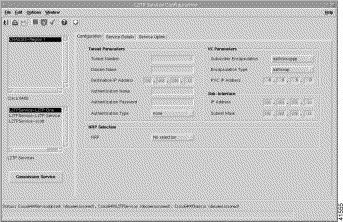
See the "Configuration Tab" section for details on the parameters displayed.
Step 2 Select the appropriate Cisco 6400 and L2TP Service from the lists displayed on the left side of the window.
Only the L2TP service instance objects (for the selected chassis) are displayed in the L2TP Services list. Service instances for other service types are listed in their appropriate Service Configuration windows. For example, IP Uplink service instance objects are displayed in the IP Uplink Configuration window. The L2TP Services list is empty when no L2TP service instances have been created. See the "Creating a Service Instance" section for details on how to create a service instance.
 |
Note Proceed to the "Configuring the L2TP Service Parameters" section when you are not applying a service profile. |
Step 3 Select Apply Profile from the Edit menu.
Step 4 Select the appropriate profile from the list of profiles displayed. The profile parameters are copied to the appropriate service instance parameters in the L2TP Service Configuration window and appear in blue.
Step 5 Configure the parameters displayed on the Configuration tab, as required.
Step 6 Select the Service Details tab.
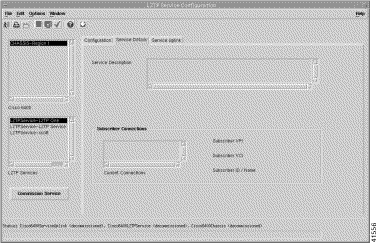
See the "Service Details Tab" section for further details on the parameters displayed.
Step 7 Enter a Service Description in the Service Details panel, if required.
Step 8 Select a connection from the Current Connection list and configure the values in the Subscriber Connections panel, as required.
Step 9 Select the Service Uplink tab.
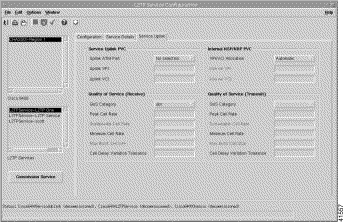
See the "Service Uplink Tab" section for further details on the parameters displayed.
Step 10 Configure the parameters displayed in the Service Uplink PCV, Quality of Service (Receive), Internal NSP, NRP PVC and Quality of Service (Transmit), as required.
A pop up window appears for you to confirm that you wish to commission the selected service.

Step 2 Select Yes to commission the service (or No to return to the L2TP Service Configuration window). The Action Report window appears.

The Action Report window details the Cisco IOS commands executed when the service is commissioned. Invalid Cisco IOS commands result in a failure to commission the service.
Step 3 Check the details in the Action Report window to ensure that the service was commissioned successfully.
 |
Caution The Cisco 6400 SCM will roll-back configuration changes applied if an error is detected in the execution of the Cisco IOS command sequence with your selected parameters. This insures that the Cisco 6400 UAC remains in a consistent state, even when errors are made entering parameters. |
Step 4 Select Save to save the Action Report, if required.
Step 5 Select Close to close the Action Report window and return to the Service Instance Configuration window.
Step 6 Select Save from the File menu to save the parameters configured.
Step 7 Select Close from the File menu to close the L2TP Service Configuration window.
To configure and commission an RFC1483 Bridging service instance, follow these steps:
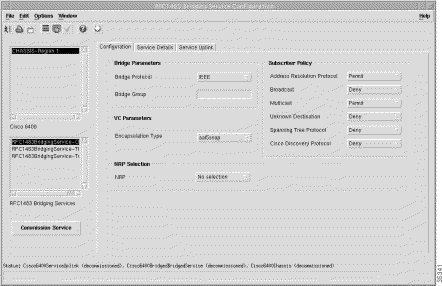
See the "Configuration Tab" section for further details on the parameters displayed.
Step 2 Select the appropriate Cisco 6400 and RFC1483 Bridging Service from the lists displayed on the left side of the window.
Only the RFC1483 Bridging service instance objects (for the selected chassis) are displayed in the RFC1483 Bridging Services list. Service instances for other service types are listed in their appropriate Service Configuration windows. For example, L2TP service instance objects are displayed in the L2TP Configuration window. The RFC1483 Bridging Services list is empty when no RFC1483 Bridging Service instances have been created. See the "Creating a Service Instance" section for details on how to create a service instance.
 |
Note Proceed to the "Configuring the RFC1483 Bridging Service Parameters" section when you are not applying a service profile. |
Step 3 Select Apply Profile from the Edit menu.
Step 4 Select the appropriate profile from the list of profiles displayed. The profile parameters are copied to the appropriate service instance parameters in the RFC1483 Bridging Service Configuration window and appear in blue.
Step 5 Configure the parameters displayed in the Bridge Parameters, VC Parameters, and Subscriber Policy panels, as required.
Step 6 Select the Service Details tab.
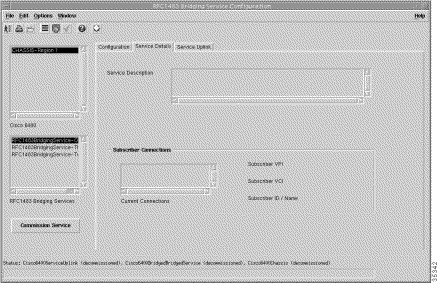
See the "Service Details Tab" section for further details on the parameters displayed.
Step 7 Enter a Service Description in the Service Details panel, if required.
Step 8 Select a connection from the Connection list and configure the values in the Subscriber Connections panel, as required.
Step 9 Configure the parameters displayed in the Subscriber Connections panel.
Step 10 Select the Service Uplink tab.
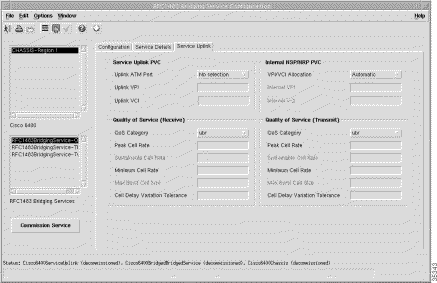
See the "Service Uplink Tab" section for further details on the parameters displayed.
Step 11 Configure the parameters displayed in the Service Uplink PCV, Quality of Service (Receive), Internal NSP, NRP PVC, and Quality of Service (Transmit) panels, as required.
A pop up window appears for you to confirm that you wish to commission the selected service.

Step 2 Select Yes to commission the service (or No to return to the RFC1483 Bridging Service Configuration window). The Action Report window appears.

The Action Report window details the Cisco IOS commands executed when the service is commissioned. Invalid Cisco IOS commands result in a failure to commission the service.
Step 3 Check the details in the Action Report window to ensure that the service was commissioned successfully.
 |
Caution The Cisco 6400 SCM will roll-back configuration changes applied if an error is detected in the execution of the Cisco IOS command sequence with your selected parameters. This insures that the Cisco 6400 UAC remains in a consistent state, even when errors are made entering parameters. |
Step 4 Select Save to save the Action Report, if required.
Step 5 Select Close to close the Action Report window and return to the Service Instance Configuration window.
Step 6 Select Save from the File menu to save the parameters configured.
Select Close from the File menu to close the RFC1483 Bridging Service Configuration window.
To configure and commission an RFC1483 IRB service instance, follow these steps:
The RFC1483 IRB Service Configuration window appears.
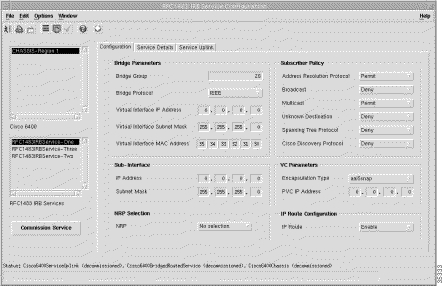
See the "Configuration Tab" section for further details on the parameters displayed.
Step 2 Select the appropriate Cisco 6400 and RFC1483 IRB Service Instance from the lists displayed on the left side of the window.
Only the RFC1483 IRB service instance objects (for the selected chassis) are displayed in the RFC1483 IRB Services list. Service instances for other service types are listed in their appropriate Service Configuration windows. For example, L2TP service instance objects are displayed in the L2TP Configuration window. The RFC1483 IRB Services list is empty when no RFC1483 IRB Service instances have been created. See the "Creating a Service Instance" section for details on how to create a service instance.
 |
Note Proceed to the "Configuring the RFC1483 IRB Service Parameters" section when you are not applying a service profile. |
Step 3 Select Apply Profile from the Edit menu.
Step 4 Select the appropriate profile from the list of profiles displayed. The profile parameters are copied to the appropriate service instance parameters in the RFC1483 IRB Service Configuration window and appear in blue.
Step 5 Configure the parameters displayed on the Configuration tab, as required.
Step 6 Select the Service Details tab.

See the "Service Details Tab" section for details on the parameters displayed.
Step 7 Enter a Service Description in the Service Details panel, if required.
Step 8 Select a connection from the Connection list and configure the values in the Subscriber Connections panel, as required.
Step 9 Select the Service Uplink tab.
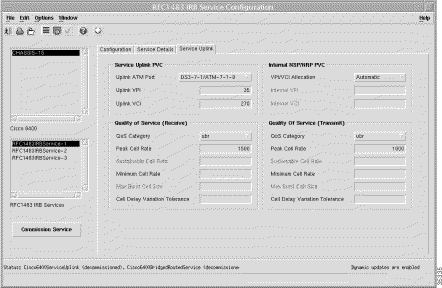
See the "Service Uplink Tab" section for details on the parameters displayed on the Service Uplink tab.
Step 10 Configure the parameters displayed on the Service Uplink tab, as required.
Step 11 Click Commission Service to roll the service onto the Cisco 6400 UAC.
A pop up window appears for you to confirm that you wish to commission the selected service.

Step 12 Select Yes to commission the service (or No to return to the RFC1483 IRB Service Configuration window). The Action Report window appears.

The Action Report window details the Cisco IOS commands executed when the service is commissioned. Invalid Cisco IOS commands result in a failure to commission the service.
Step 13 Check the details in the Action Report window to ensure that the service was commissioned successfully.
 |
Caution The Cisco 6400 SCM will roll-back configuration changes applied if an error is detected in the execution of the Cisco IOS command sequence with your selected parameters. This insures that the Cisco 6400 UAC remains in a consistent state, even when errors are made entering parameters. |
Step 14 Select Save to save the Action Report, if required.
Step 15 Select Close to close the Action Report window and return to the Service Instance Configuration window.
Step 16 Select Save from the File menu to save the parameters configured.
Select Close from the File menu to close the RFC1483 IRB Service Configuration window.
 |
Note You must configure the parameters displayed in the SSG Configuration window before configuring and commissioning an IP Uplink service instance. See the "Configuring SSG Configuration" section for further details. |
To configure and commission an IP Uplink service instance, follow these steps:
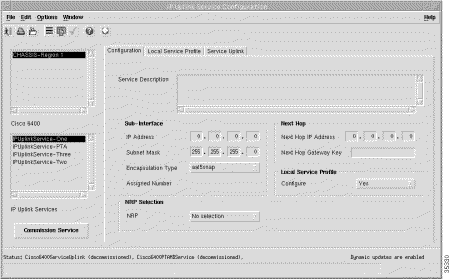
See the "Service Uplink Tab" section for further details on the parameters displayed.
Step 2 Select the appropriate Cisco 6400 and IP Uplink service instance from the lists displayed on the left side of the window.
Only the IP Uplink service instance objects (for the selected chassis) are displayed in the IP Uplink Services list. Service instances for other service types are listed in their appropriate Service Configuration windows. For example, L2TP service instance objects are displayed in the L2TP Configuration window. The IP Uplink Services list is empty when no IP Uplink Service instances have been created. See the "Creating a Service Instance" section for details on how to create a service instance.
 |
Note Proceed to the "Configuring the IP Uplink (for PTA-MD and RBE Subscribers) Service Parameters" section when you are not applying a IP Uplink service profile. |
Step 3 Select Apply Profile from the Edit menu.
Step 4 Select the appropriate profile from the list of profiles displayed. The profile parameters are copied to the appropriate service instance parameters in the IP Uplink Service Configuration window and appear in blue.
Step 5 Configure the parameters displayed on the IP Uplink Configuration tab, as required.
Step 6 Select the Local Service Profile tab.
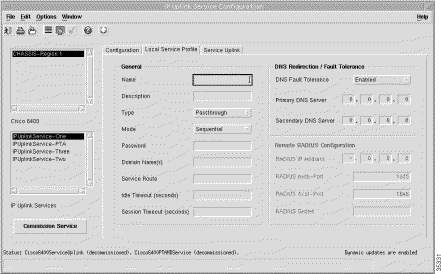
See the "Local Service Profile Tab" section for further details on the parameters displayed.
Step 7 Configure the parameters displayed on the Local Service Profile tab, as required.
Multiple Domain Names (displayed in the General panel) can be entered. Each name must be separated by a semi-colon with no spaces. When the Service Route (displayed in the General panel) spans two routers you must enter a string separated by semi-colons (;) and no spaces. For example, 192.168.38.5;255.255.255.0;192.168.95.3;255.255.252.0
Step 8 Configure the parameters displayed on the Local Service Profile tab, as required.
Step 9 Select the Service Uplink tab.

See the "Service Uplink Tab" section for further details on the parameters displayed.
Step 10 Configure the parameters displayed on the Service Uplink tab, as required.
Step 11 Click Commission Service to roll the service onto the Cisco 6400 UAC. A pop up window appears for you to confirm that you wish to commission the selected service.

Step 12 Select Yes to commission the service (or No to return to the IP Uplink Service Configuration window). The Action Report window appears.

The Action Report window details the Cisco IOS commands executed when the service is commissioned. Invalid Cisco IOS commands result in a failure to commission the service.
Step 13 Check the details in the Action Report window to ensure that the service was commissioned successfully.
 |
Caution The Cisco 6400 SCM will roll-back configuration changes applied if an error is detected in the execution of the Cisco IOS command sequence with your selected parameters. This insures that the Cisco 6400 UAC remains in a consistent state, even when errors are made entering parameters. |
Step 14 Select Save to save the Action Report, if required.
Step 15 Select Close to close the Action Report window and return to the Service Instance Configuration window.
Step 16 Select Save from the File menu to save the parameters configured.
Select Close from the File menu to close the IP Uplink Service Configuration window.
To configure and commission an RFC1483 routing service instance, follow these steps:

See the "RFC1483 IRB Service Profile Configuration Window" section for further details on the parameters displayed.
Step 2 Select the appropriate Cisco 6400 and RFC1483 Routing Service instance from the lists displayed on the left side of the window.
 |
Note RFC1483 Routing service profiles cannot be created for the RFC1483 Routing service and therefore cannot be applied. |
Step 3 Configure the parameters displayed on the Configuration tab, as required.
Step 4 Select the Service Details tab.

Step 5 Enter a Service Description in the Service Details panel, when required.
Step 6 Select a connection from the Current Connection list and configure the parameters in the Subscriber Connections panel, as required.
Step 7 Select the Service Uplink tab.
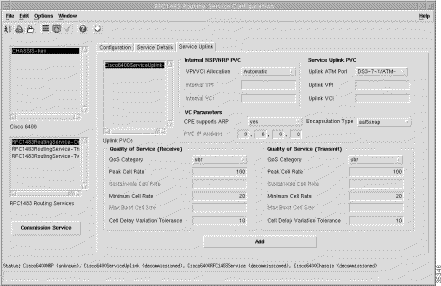
See the "RFC1483 Routing Service Configuration Window" section for further details on the parameters displayed.
Step 8 Configure the parameters displayed on the Service Uplink tab, as required.
Step 9 Click Add to add a new service uplink. The RFC1483 services can have multiple service uplinks.
Step 10 Click Commission Service to roll the service onto the Cisco 6400 UAC. A pop up window appears for you to confirm that you wish to commission the selected service.

Step 11 Select Yes to commission the service (or No to return to the RFC1483 Routing Service Configuration window). The Action Report window appears.

The Action Report window details the Cisco IOS commands executed when the service is commissioned. Invalid Cisco IOS commands result in a failure to commission the service.
Step 12 Check the details in the Action Report window to ensure that the service was commissioned successfully.
 |
Caution The Cisco 6400 SCM will roll-back configuration changes applied if an error is detected in the execution of the Cisco IOS command sequence with your selected parameters. This insures that the Cisco 6400 UAC remains in a consistent state, even when errors are made entering parameters. |
Step 13 Select Save to save the Action Report, if required.
Step 14 Select Close to close the Action Report window and return to the Service Instance Configuration window.
Step 15 Select Save from the File menu to save the parameters configured.
Select Close from the File menu to close the RFC1483 Routing Service Configuration window.
Figure 9-85 displays a typical work flow that describes how to create, configure and connect subscribers (that is, provision end customers).
The first step is to create (deploy) one or more subscriber objects. Each subscriber object can then be configured with their own particular details (for example, connection or contact details).
Each subscriber can then be connected to one or more service instances. Service instances were created earlier. See the "Creating a Service Instance" section for further details.
Subscriber objects hold information related to the end subscriber. Subscribers are created by deploying them onto a selected Line Card.
To create subscribers, follow these steps:
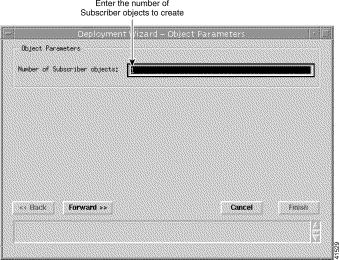
Step 2 Enter the Number of Subscriber objects you wish to create. A single Subscriber object was entered in the example. (see Figure 9-86)
Step 3 Select Forward. The Deployment Wizard - Object Parameters (2 of 2) window appears. (see Figure 9-87)
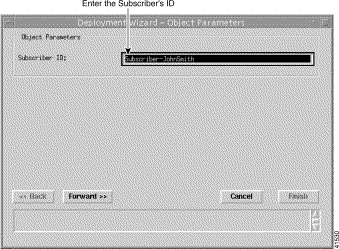
Step 4 Enter a Subscriber ID. John Smith was entered in the example. (see Figure 9-87)
Step 5 Click Forward.
 |
Note Repeat steps 4 and 5 for the Number of Subscribers entered in step 2. |
Step 6 Click Forward. The Deployment Wizard Summary window appears (see Figure 9-88).
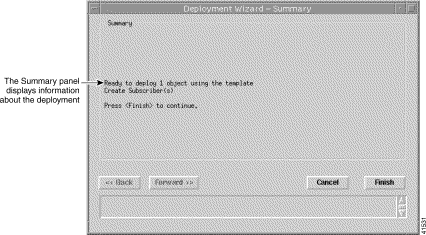
Summary information displays in the Summary panel.
Step 7 Check the Summary information is correct.
Step 8 Click Finish (when the Deployment Summary information is correct) to create the new Subscriber objects.
Step 9 Proceed to the "Configuring a Subscriber" section.
To delete a subscriber object, follow these steps:
Step 2 Select the Subscriber from the list at the left side of the window and right click.
Step 3 Select Delete Objects.
Step 4 Check the Deletion Summary details.
Step 5 Click Finish.
To configure a subscriber's details, follow these steps:

See the "Subscriber Configuration Window" section for details on the parameters that appear on the Subscriber Configuration window.
Step 2 Select a Cisco 6400 and Subscriber from the appropriate lists at the left side of the window.
Step 3 Select a Current Connection from the list displayed in the Connection Details panel.
Step 4 Configure the parameters displayed in the Connection Details panel.
Step 5 Select the Subscriber Details (Optional) tab.

 |
Note Entering information into the Subscriber Details (Optional) tab is voluntary. You can enter any information you like into the Subscriber Details tab. For example, you may decide to enter a subscriber identification in the Subscriber Name box and an e-mail address in the Subscriber Address box. |
Step 6 Enter a Contact ID / Name and Contact Address into the Contact Name & Address panel, as required.
Step 7 Enter a Subscriber ID / Name and Subscriber Details into the Subscriber Name & Address panel, as required.
Step 8 Select the Save option from the File menu to save the subscriber information.
Step 9 Select the Close option from the File menu to close the Subscriber Configuration window.
Subscribers are connected to service instances within the Service/Subscriber Connection window. The Service/Subscriber Connection window displays three tabs: Connection details, Connect to Single Domain, and Connect to Multi-Domain. Configuration information is required into one or more tabs when connecting a subscriber to a service instance. Certain parameters are grayed out, depending upon what type of service you are trying to connect to.
Table 9-2 displays the Cisco 6400 SCM service types and the tabs in the Service/Subscriber Connection window that should be configured for each service type.
| Cisco 6400 Service Type | Connection Details Tab | Connect To Single Domain Tab | Connect to Multi-Domain Tab |
Pure ATM Switching Service | Configure the parameters displayed in the Connection Parameters and Internal NSP, NRP PVC panels for all service types, as required. | Configure the parameters displayed, as required for all service types. Click Connect when required. | Not required |
PPPoA Single Domain | Not required | ||
L2TP | Not required | ||
RFC1483 Routing | Not required | ||
RFC1483 Bridging | Not required | ||
RFC1483 IRB | Not required | ||
IP Uplink | Configure the parameters displayed, as required. Click Connect when required. |
To connect a subscriber to a service instance, follow these steps:
The Service/Subscriber Connection window (shown in Figure 9-91) appears. See the "Service/Subscriber Connection Window" section for further details on the parameters displayed.

Step 2 Select a Cisco 6400 chassis from the Cisco 6400 list displayed on the left side of the window.
Step 3 Select a Subscriber from the Subscriber list displayed on the left side of the window.
Step 4 Select a Connection Template from the Connection Template list displayed on the left side of the window.
Step 5 Configure the parameters in the Connection Parameters, and Internal NPS, NRP PVC frames, as required.
Step 6 Select the Connect to Single Domain tab.
 |
Note When you select an IP Uplink service (Service Type of PTA-MD) and this service instance does not have a Local Service Profile (LSP) configured, the Connect button is grayed out. When you do connect to an IP Uplink service using the Connect to Single Domain tab, this is equivalent to the PTA-MD static case used in Release 1.3 of the Cisco 6400 SCM software. |
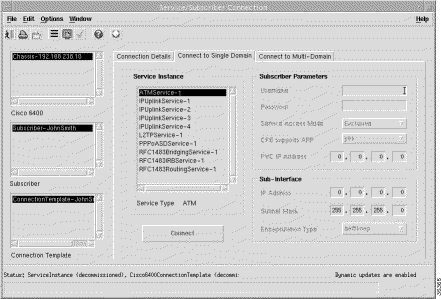
Step 7 Select a Service Instance from the list displayed in the Service Instance panel.
A Service Instance is a service object, that is, a single service deployed on the Cisco 6400 UAC. It contains all of the configuration information required for the service to run.
 |
Note Inappropriate parameters are grayed out in each of the frames displayed on the Connection Details, Connect to Single Domain, and Connect to Multi-Domain tabs when a Service Instance is selected. |
Step 8 Configure the parameters displayed in the Connect to Single Domain tab, as required.
Step 9 Select the Connect to Multi-Domain tab.
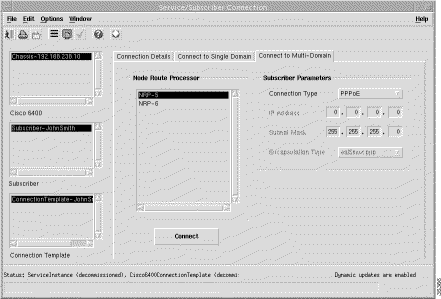
Step 10 Select an NRP from the Node Route Processor list.
Step 11 Configure the parameters displayed in the Connect to Multi-Domain tab, as required.
Step 12 Click Connect. A pop up window appears (see Figure 9-94) asking you to confirm that you wish to connect the selected subscriber.

Step 13 Click Yes to proceed. An Action report window appears displaying the Cisco IOS transaction log as connection occurs.
 |
Note A Subscriber connection object is automatically created and placed below the appropriate service instance in the Cisco6400ServiceView and also in the Cisco6400SubscriberView below the appropriate subscriber object. Performance logging can be Activated or Deactivated for each subscriber connection object. See Table 8-1 for further details. |
 |
Note The Connect button is grayed out when the Service Instance is in a Commissioned state. |
If the Connect operation fails the service instance remains in the Decommissioned state (that is, no configuration is applied to the Cisco 6400 UAC). The Action Report window may identify why the connection failed. Failure diagnostics information can also be located by examining the Cisco IOS log.
Common failure causes can include:
To disconnect a subscriber from a service instance, follow these steps:

See the "Service/Subscriber Disconnection Window" section for further details on the parameters contained in the Service/Subscriber Disconnection window.
Step 2 Select the Cisco 6400 chassis and ATM Port from the lists displayed on the left side of the window.
Step 3 Select a Subscriber and Current Connections from the from the lists displayed in the Connection Details panel.
Step 4 Click Disconnect. A pop up window appears to inform you that the selected subscriber is about to be disconnected.

Step 5 Click Yes to disconnect the subscriber. The Action Report window appears confirming that the subscriber was disconnected.

Step 6 Click Close to close the Action Report window or click Save to save the Action Report. The Action Report can be saved and used for diagnostic purposes. The "*** No errors encountered *** " message appears to show that disconnection was successful.
This operation can be performed without disconnecting the subscriber.
To edit a currently connected subscriber's details, follow these steps:
Step 2 Select the NSP, DSLAM and Subscriber to display the subscribers details.
Step 3 Enter the Contact and Subscriber Details and then save your changes.
To move subscribers between services (or NRPs), follow these steps:
Step 2 Select the subscriber to disconnected.
Step 3 Press the Disconnect button.
Step 4 Select a new service.
Step 5 Connect the subscriber to a new service instance (and NRP, if appropriate).
![]()
![]()
![]()
![]()
![]()
![]()
![]()
![]()
Posted: Fri Aug 4 02:08:54 PDT 2000
Copyright 1989-2000©Cisco Systems Inc.